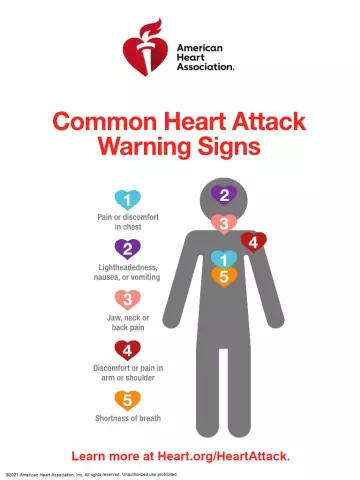- Author Rachel Wainwright [email protected].
- Public 2023-12-15 07:39.
- Last modified 2025-11-02 20:14.
First aid for hypertensive crisis
Hypertensive crisis is an acute condition characterized by a sharp rise in blood pressure (BP), which carries an immediate threat to life. Therefore, it is important to know the signs of this condition and be able to provide first aid in case of a hypertensive crisis.
Blood pressure values in normal conditions and in crisis

Despite the fact that it is the rise in blood pressure that is the cause of the hypertensive crisis, there is no clear quantitative indicator of blood pressure, which would indicate that what is happening is a hypertensive crisis, and not something else. For this reason, doctors recommend that patients with cardiovascular and renal pathology (namely, such patients are primarily at risk) to know their so-called working pressure - blood pressure indicators that correspond to their normal state of health in the absence of emotional and physical stress.
This parameter may differ in people, since the rate of blood pressure fluctuates within quite significant limits - from 110 to 140 mm Hg. for the systolic (upper) indicator, and from 60 to 90 mm Hg. for diastolic (lower). For most people who do not have hypertension, the norm is a systolic blood pressure of 110 mm Hg, respectively, an increase in pressure even up to 120 mm Hg. may indicate pathology, while for a person prone to hypertension, an indicator of 140 mm Hg. may be the norm.
If the patient knows his working pressure, then, starting from this, it is possible to determine a condition that is a hypertensive crisis or threatens to become one. For example, if a person's usual well-being corresponds to a pressure of 110/70 mm Hg, then an indicator of 120/80 will already indicate hypertension.
It should be borne in mind that not every person with a hypertensive crisis knows their working pressure, sometimes the victim cannot give the correct answer during the ongoing crisis due to poor health, and besides, there is not always a tonometer at hand to measure blood pressure. Therefore, to provide first aid, you need to know other signs of a hypertensive crisis.
Signs of a hypertensive crisis
Signs of a hypertensive crisis are:
- A sharp or worsening headache, especially in the occipital region;
- Squeezing feeling in the head;
- Feeling of blood pulsation in the temples;
- Redness or vice versa, blanching of the skin;
- Tinnitus;
- Pain in the eyes, "flies" before the eyes, blurred vision;
- Shortness of breath, chest pain and tachycardia (heart palpitations) may occur;
- Nausea, vomiting is possible;
- Increased irritability, a sharp reaction to bright light, loud sounds and other pathogens.
A hypertensive crisis can develop abruptly, or it can develop gradually, with a slow increase in symptoms. The first type of crisis is called hyperkinetic, it is characteristic of people in the early stages of hypertension. For this type, in addition to the acute onset, not too high blood pressure indicators are characteristic. The second type is called hypokinetic, as a rule, it occurs in people who have long suffered from hypertension, blood pressure rises significantly, and the symptoms of a crisis can persist from several hours to several days. Both types can lead to extremely dangerous health consequences, up to and including death.
First aid for hypertensive crisis
The first thing to do if you suspect a hypertensive crisis is to call an ambulance. The sooner a person receives qualified help, the sooner it will be possible to stop the attack and the less the risk of developing severe complications of the crisis.
There is an exception to this rule. Many patients with long-term hypertension already know how to stop the crisis themselves, recognizing its approach by the first symptoms and taking the necessary medications according to the algorithm drawn up by the attending physician. In this case, having taken the necessary medications, the person should still remain under supervision, and only after making sure that the medications have worked and the victim's condition improves, one can refuse to call emergency help. However, you should notify your doctor about the incident as soon as possible.
In all other cases, while waiting for the arrival of an ambulance, you need to do the following:
- Lay the patient with his head up. If the headache worsens while lying down, you can take a comfortable sitting position;
- Provide the patient with complete peace, both physical and emotional;
- Provide fresh air: open a window, loosen tight clothing;
- If circumstances permit, carry out procedures aimed at the outflow of blood: apply cold to the head, put mustard plasters on the collar zone, calf muscles. You can make a hot foot bath.

When providing first aid for a hypertensive crisis, it is important to remember that, despite the intense headache, the patient should not be given any drugs "from the head", "from the heart", etc., which by chance turned out to be available in action before the ambulance arrives. which you are not sure. Pain relievers are undesirable, as they complicate the subsequent diagnosis, without eliminating the causes of the crisis. But even if it is known that a drug that accidentally came to hand has an antihypertensive (lowering pressure) effect, it must be borne in mind that drug treatment in such a situation should be prescribed and monitored by a doctor, since a too sharp decrease in blood pressure during a hypertensive crisis can also lead to severe consequences.
Found a mistake in the text? Select it and press Ctrl + Enter.






